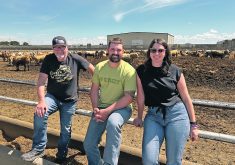Yes, you need a succession plan, says Nick Betts, a business management specialist with Ontario Agriculture.
A succession or transition plan proactively charts the farm’s future rather than reacting to future events such as a death, a health crisis or a divorce, he says.
“If you owned any other kind of business, you would have distinct goals and targets to meet … and you would also have an exit strategy.”
As outlined on the ministry’s website at Ontario.ca/agbusiness, succession planning can be broken into steps.
Read Also

Bunge’s crop mix is changing
Bunge has predominantly been a soybean processing firm, but that’s about to change after the merger with Viterra with softseed processing and grain merchandising gaining ground.
There are four other stories in this Strategies series:
- Navigating farm succession: a tool kit
- Price of a lifetime
- Incorporation may offer one solution to succession
- The soft side of selling: letting go of the farm
The first and crucial step is to talk to each other. Have everyone write down their goals and objectives for themselves, the family and the business.
Identify a successor. Becoming a successor might be a goal of one or more of the next generation. If that’s the case, you’ll focus on transferring the business to those individuals. If there are no potential successors, the emphasis will be on preserving family wealth and the transition out of farming
With the successors identified, the next step is to figure out how to reach a consensus between the two factions on their major objectives. The successors may want to take over the farm immediately, but if the founders want to remain involved, a satisfactory compromise must be found.
Founders need to figure out how much money they will require for retirement and successors need to figure out what they can afford to pay for the farm business.
Betts recommends securing the services of a trained outside facilitator to assist in these discussions — particularly around the area of family members’ objectives, goals and expectations.
“A number of factors affect objectives and goals,” he says. “These include past family history, family values, personality conflicts, family relationship dynamics, favouritism, life stages issues and associated challenges.”
Step 1: Collect and analyze information
Gather financial information and use it to analyze the financial viability and profitability of the farm. Read articles about succession planning and attend succession planning workshops or seminars.
Pull together all the technical info about the farm — the legal will of the owner, the power of attorney, tax returns, financial statements, current financing arrangements, retirement savings position, as well as business and legal agreements.
Use the financial statements to analyze the farm business’s past and current financial situation and to project what the future will look like.
A key question to answer is whether the business generates enough profit to support another household, provide for a financially secure retirement for the founders and ensure a financially sound business for the successors. Keep plans such as marriage, quitting off-farm jobs or building a house in mind.
Review additional specific technical information. Start thinking about methods of transfer of the farm, financing options, tax and legal considerations, business structures. This information will be helpful for Step 2.
Step 2: Generate options
Some issues that need to be addressed include: ownership transferral possibilities; financing options; business organization options (sole proprietorship, partnership, corporation); legal considerations such as wills and power of attorney; inclusion of dispute resolution mechanisms in business agreements; tax strategies and implications
Brainstorm “what if?” scenarios and develop contingencies to address disagreement, disaster, death, disability and divorce.
While keeping the farm family in control, create a team of advisers. This team might include a facilitator, an accountant and a lawyer. It might also include a lender or credit adviser, business adviser, a financial planner, an insurance specialist along with farm family members. It is a good idea to have a team meeting to discuss goals, objectives and expectations along with options.
Step 3: Make preliminary decisions
The family needs to make preliminary decisions on the direction of the plan.
The team of advisers can provide input, comments and suggestions regarding various options and decisions.
Once goals, how to achieve them and a time frame are decided, the family needs to document the narrowed-down options in a rough draft.
Step 4: Design, develop, write and review
Don’t be afraid to go back and make changes.
The written succession plan will include:
- a summary of the overall plan
- a business overview
- a strategic plan with a description of the personal and business goals and expectations of family members
- a retirement plan
- a management, control and labour transfer plan
- a financial plan
- an action plan and implementation timetable
- supporting documentation.
- The written plan can also include:
- a training and development plan for the successors
- a communication plan
- a contingency plan
As decisions are documented, the team of advisers reviews the plan and provides detailed feedback, advice and comments.
Once this occurs, the family should conduct a review, have a discussion and make necessary modifications.
Additional information on the contents of a written plan can be found in Ontario Agriculture’s fact sheet, Components of a Farm Succession Plan, Order No. 10-023.
Step 5: Implement and monitor
Provide copies of the plan to family members. Monitor progress as the plan is implemented. If issues arise, the plan needs to be modified. Be flexible.
Betts says getting interested parties in on the plan can tricky.
He advises getting all of the owners and decision makers of the business into a meeting.
“This can happen anywhere, but preferably not around the kitchen table,” he said.
“If it’s a business meeting, separate it as much as possible from the typical family events, like dinner.
“Go to a neutral, professional place and have that first conversation with all the ownership involved.
“Include all the stakeholders. Transparency is key to the process.”














